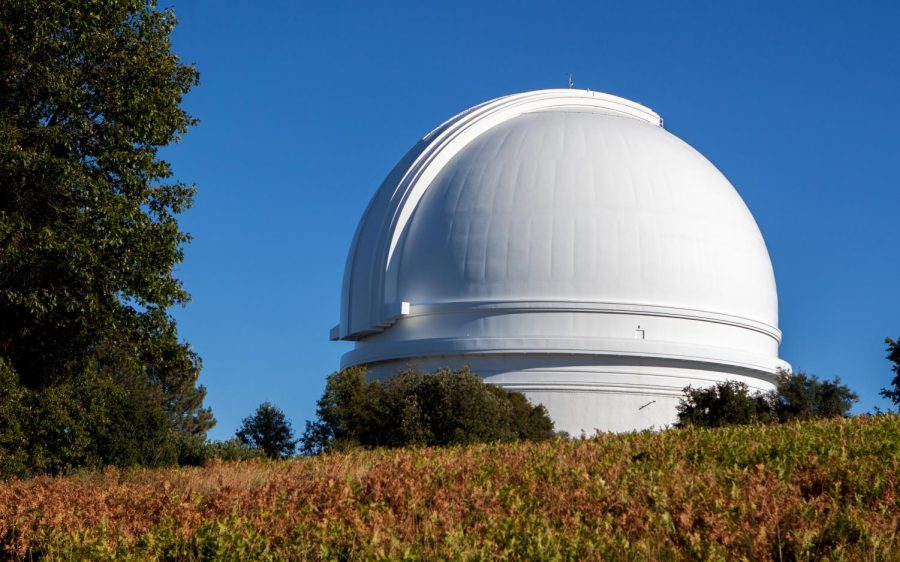Historically Speaking: The eye on the sky right in our back yard
The Palomar Observatory, located in northeast San Diego County. (Photo by Kevin Hudnell, iStock Getty Images)
February 4, 2023
There’s little doubt that among our younger generations there are a great many who are unaware that the one-time world’s largest astronomical telescope is located on nearby Palomar Mountain, which is less than an hour’s drive from the North San Diego County communities of Oceanside, Vista, San Marcos or Escondido.
With a $6 million grant from the Rockefeller Foundation, astronomer George Ellery Hale orchestrated the planning, design and construction of the observatory. But it took 20 years for the project to be completed, and Hale did not live to see its commissioning.
The Hale telescope was groundbreaking for its time, with double the diameter of the second-largest telescope, the Mt. Wilson Observatory north of Los Angeles, which had a 100-inch reflecting telescope.
 Palomar has pioneered many new technologies in telescope-mount design and in the fabrication of its large 200-inch aluminum-coated “honeycomb” Pyrex mirror. The project was completed in 1949 and today continues in active use as one of the world’s largest and most-sophisticated land-mounted telescopes.
Palomar has pioneered many new technologies in telescope-mount design and in the fabrication of its large 200-inch aluminum-coated “honeycomb” Pyrex mirror. The project was completed in 1949 and today continues in active use as one of the world’s largest and most-sophisticated land-mounted telescopes.
In 1928, Hale published an article in Sky Magazine proposing what was to become the 200-inch Palomar reflector; it was an invitation to the American public to learn about how large telescopes could help answer questions relating to the fundamental nature of the universe. Over the years, Hale’s telescope has uncovered millions of celestial objects in the far reaches of the universe that before were virtually unknown.
For more than 30 years, the Hale telescope represented the technological limit in building large optical telescopes. It was the largest telescope in the world from its completion in 1949 until the Soviet Union (Russia) built a larger one in 1976.
Edwin Powell Hubble was the first astronomer to use the telescope. Palomar remained the world’s second largest until 1993 with the construction of the 300-plus-inch Keck Observatory on Maui in Hawaii.
Palomar was built and is operated by the California Institute of Technology. The 200-inch giant continues to be engaged in research programs that cover the vast range of our observable universe, including studies of near-Earth asteroids, outer solar system planets, Kuiper Belt objects, a variety of star formations, and black holes.
Palomar Mountain’s northeast (desert) side location was selected because of its remote location away from the city lights of Los Angeles and San Diego. Palomar Mountain actually is a 15-mile-long, 4,000- to 6,000-foot elevation mountain range. In the 1920s, when Hale first conceived of the San Diego County Observatory, Escondido and Oceanside were small communities. Portions of nearby the Riverside County desert didn’t have electricity, and Temecula wasn’t even a wide spot in the road along U.S. 395 (Interstate 15).
Today, Palomar Observatory continues as one of the world’s most sophisticated astronomical research complexes, with multiple telescopes. Research time is granted by Caltech and its research partners, which include the Jet Propulsion Laboratory, Yale University, and the National Optical Observatories of China.
The first telescope built at the observatory complex was an 18-inch Schmidt camera device put into operation in 1936. In addition to the giant 200-inch Hale telescope, there is the 48-inch Schmidt telescope, the Palomar 60-inch telescope, and the 12 inch Gattini telescope, all of which are involved in continual research. The 48-inch and 60-inch telescopes operate robotically and are active in deep-space exploration.
While Palomar Observatory is a research facility, there are selected observatory areas open to the public during the day. Visitors can take self-guided tours of the 200-inch telescope daily from 9 a.m. to 3 p.m. The observatory is open seven days a week, year-round, except for Dec. 24-25 and during times of inclement weather. Guided tours of the 200-inch telescope dome and observing area are available Saturdays and Sundays during the months of April through October. Behind-the-scenes tours for the public are offered through a community support group, Palomar Observatory Docents.
Palomar Observatory also has an on-site museum: The Greenway Visitor Center containing observatory and astronomy-relevant exhibits, a gift shop, and a hosting site for periodic public events.
The observatory’s county road S-56 leads up the mountain to the complex from state Route 76, east of Interstate 15. It’s about a one-hour drive from Escondido or Oceanside. For RV and camping enthusiasts, the nearby Palomar Campground has an easy 2-mile walking path to the observatory. The observatory grounds are a favorite area for amateur astronomers using their personal telescopes, but dress warm because even during the summer months, the observatory’s 6,142-foot elevation can get a bit chilly.
For those unable to travel to the observatory, Palomar provides an extensive internet tour that provides virtual access to all the major onsite research telescopes. The Greenway Center has extensive embedded multimedia to provide additional context. Similarly, the observatory actively maintains an extensive website and YouTube channel for more detailed information.
Tom Morrow is a longtime Oceanside-based journalist and author.
Columns represent the views of the individual writer and do not necessarily reflect those of the North Coast Current’s ownership or management.




